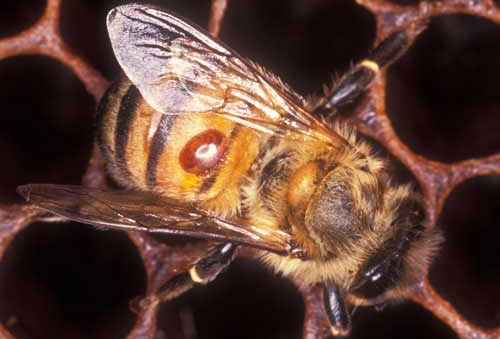
Posts Tagged: mite
Fungus Helps a Honeybee
New fungus strain could provide a chemical-free method to help honey bees
Jennifer Han
jennifer.o.han@wsu.edu
PULLMAN, Wash. -- A new fungus strain could provide a chemical-free method for eradicating mites that kill honey bees, according to a study published this month in Scientific Reports.
A team led by Washington State University entomologists bred a strain of Metarhizium, a common fungus found in soils around the world, to work as a control agent against varroa mites. Unlike other strains of Metarhizium, the one created by the WSU research team can survive in the warm environments common in honey bee hives, which typically have a temperature of around 35 Celsius (or 95 F).
"We've known that metarhizium could kill mites, but it was expensive and didn't last long because the fungi died in the hive heat," said Steve Sheppard, professor in WSU's Department of Entomology and corresponding author on the paper. "Our team used directed evolution to develop a strain that survives at the higher temperatures. Plus, Jennifer took fungal spores from dead mites, selecting for virulence against varroa."
Jennifer Han, a post-doctoral researcher at WSU, led the breeding program along with WSU assistant research professors Nicholas Naeger and Brandon Hopkins. Paul Stamets, co-owner and founder of Olympia-based business Fungi Perfecti, also contributed to the paper. Stamets is a fungi expert, well-known for using several species in applications ranging from medicine to biocontrol.
Varroa destructor mites, small parasites that live on honey bees and suck their "blood," play a large role in Colony Collapse Disorder, which causes beekeepers to lose 30-50% of their hives each year. The mites feed on bees, weakening their immune systems and making them more susceptible to viruses.
The main tools beekeepers use to fight varroa are chemicals, such as miticides, but the tiny pests are starting to develop resistance to those treatments, Naeger said.
Metarhizium is like a mold, not a mushroom. When spores land on a varroa mite, they germinate, drill into the mite, and proliferate, killing it from the inside out. Bees have high immunity against the spores, making it a safe option for beekeepers.
Stamets, who did some of the initial testing with Metarhizium that showed the fungus couldn't survive hive temperatures, was impressed by the work done by the WSU researchers.
"Science progresses through trial and error, and my technique wasn't economical because of the hive heat," he said. "But Jennifer did enormous amounts of culture work to break through that thermal barrier with this new strain. It's difficult to really appreciate the Herculean effort it took to get this."
Han and Naeger screened more than 27,000 mites for levels of infection to get the new strain.
"It was two solid years of work, plus some preliminary effort," Han said. "We did real-world testing to make sure it would work in the field, not just in a lab."
This is the second major finding to come from WSU's research partnership with Stamets involving bees and fungi. The first involved using mycelium extract that reduced virus levels in honey bees.
"It's providing a real one-two punch, using two different fungi to help bees fight varroa," Stamets said. "The extracts help bee immune systems reduce virus counts while the Metarhizium is a potentially great mite biocontrol agent."
The next step is to seek approval from the Environmental Protection Agency to use Metarhizium on hives used in agriculture. The team must also finalize delivery methods for beekeepers to apply the fungus in hives.
"We hope in 10 years that, rather than chemical miticides, Metarhizium is widely used to control Varroa mites," Sheppard said. "And that the mite problem for beekeepers has been significantly reduced."
The team thinks the methods they developed to evolve Metarhizium for varroa control could be used to improve biocontrol agents in other crop systems as well.
A female Varroa destructor Anderson & Trueman, feeds on the hemolymph of a worker bee. The mite is the oval, orange spot on the bee's abdomen. Photograph by James Castner, University of Florida.
Citrus Mite Zoom
David Haviland, UCCE Farm Advisor discussed integrated pest management for five different species of mites that cause economic damage to citrus, including proper identification, monitoring, and tools for management. Biological control was also be discussed, including the use of predatory mites.
Recording of the February 2021 webinar on Mites in California Citrus by David Haviland is now available on our YouTube playlist - https://youtu.be/pIOe4ZBbYkM
Other recordings in the"Ask the Ag Experts" series from UC IPM are available at:
https://www.youtube.com/playlist?list=PLo3rG4iqv4gHBV3YA6w4wkBufwh7GBjrX
IMAGE: Citrus Red Mite Damage

citrus red mite damage
And Now Avocado Brown Mite
The weather continues to offer new opportunities. Recently there have been reports of Avocado Brown Mite infesting trees. This is a pest (Oligonychus punicae) of dust and disturbance. Normally found along picking roads and up against areas that are dusty. Not a problem. But growers in San Diego and Ventura have both commented on their unusual presents and some cause for concern. It's early appearance in the season when the spider mite destroyer hasn't yet built its population is the most likely reason. But……………
Avocado brown mite is a sporadic pest, mostly in coastal growing areas. Bronzing of leaves, mite cast skins, and partial defoliation of some trees by avocado brown mite is most noticeable from about July to September. Severe infestations tend to occur in border row trees along dirt roads, where road dust is detrimental to mite predators. Ash deposited on leaves from wildfires reportedly also causes brown mite outbreaks.
Avocado brown mite feeds almost entirely on upper leaf surfaces. Bronzing damage is not severe when mite numbers are low to moderate (about 10 to 20 adult females per leaf). If the spider mite destroyer lady beetle (Stethorus picipes) is present and reproducing well at this time, brown mite does not normally become a problem. Damage occurs if avocado brown mite averages about 80 to 100 adult females per leaf (about 200-300 motile stages, adults and nymphs combined). At these higher densities mites also colonize the lower leaf surface and sometimes fruit, and partial defoliation can occur. These higher numbers cause leaf bronzing along the midrib, then along smaller veins, and finally the entire leaf turns brown.
Brown mite is related to Persea Mite (http://ipm.ucanr.edu/PMG/r8400211.html) but rarely causes the damage that its relative can cause. The Persea Mite feeds mainly on the bottom of the leaf and forms web-covered colonies which help to distinguish it from O. punicae (first described in Carthage?).
At this stage, unless there is severe defoliation, it might be best to leave it alone until biocontrol kicks in or we get a hot spell to burn it out. Keep the trees adequately watered and flushing new leaves to outgrow it. Call a PCA if you are worried.
More about the weather:
//ucanr.edu/blogs/blogcore/postdetail.cfm?postnum=26823
And whatever happened to the Bagrada Bug?
//ucanr.edu/blogs/blogcore/postdetail.cfm?postnum=15198
Photo: Brown mite feeding on top of leaf surface

avocado bronw mite
Another Mite Threatening Honeybees
This article is from Florida Grower News. Thanks for Jim Lloyd-butler for pointing it out.
FLG-Editorial@MeisterMediaww.com
A sister species of the Varroa destructor mite is developing the ability to parasitize European honeybees, threatening pollinators already hard pressed by pesticides, nutritional deficiencies, and disease, a Purdue University study says.
Researchers found that some populations of Varroa jacobsoni mites are shifting from feeding and reproducing on Asian honeybees, their preferred host, to European honeybees, the primary species used for crop pollination and honey production worldwide. To bee researchers, it's a grimly familiar story: V. destructor made the same host leap at least 60 years ago, spreading rapidly to become the most important global health threat to European honeybees.
While host-switching V. jacobsoni mites have not been found outside of Papua New Guinea, Purdue researchers Gladys Andino and Greg Hunt say vigilance is needed to protect European honeybees worldwide from further risk.
“This could represent a real threat,” said Andino, a bioinformatics specialist with Information Technology at Purdue. “If this mite gets out of control and spreads, we might have another situation like V. destructor.”
Varroa mites are obligate parasites, meaning their lifecycle is inextricably entwined with that of their bee hosts. The mites can do serious damage to their hosts' health due to their relatively large size – “think of a tick as big as your fist,” Hunt said. Mites latch on to bees and feed on their hemolymph, insects' rough equivalent to blood, leaving behind open wounds that are susceptible to infection. They can also transmit diseases such as deformed wing virus and have been linked to colony collapse disorder.
To gain insight into the biology behind V. jacobsoni‘s host switch, Andino and Hunt, professor of behavioral genetics and honeybee specialist, studied the differences in gene expression between V. jacobsoni mites that fed and reproduced on Asian honeybees and those that parasitized European honeybees. Knowing which host cues mites respond to and the genes involved could lead to potential control strategies, the researchers said.
“If we can understand the mechanism, we might be able to disrupt, block, or manipulate that,” Andino said. “But first we have to understand what is happening and which genes are involved in allowing the mites to shift to a new host.”
Andino and Hunt said the mites' leap to European honeybees likely occurred within the last decade. Previously, V. jacobsoni mites were occasionally found on European honeybees but seemed unable to produce healthy offspring, limiting their destructive capacity.
Catching the host transition in its early stages will allow researchers to continue to investigate the complex genetic details behind the shift and monitor infected European honeybees, Hunt said.
“This happened once with one species of mite, and it looks like it's happening again. Maybe if we catch this as it's beginning, we'll be able to figure out why it's happening or, down the road, stop it.”
The paper was recently published in BMC Genomics.
Funding for the study and an ongoing genome-sequencing project was provided USDA's-Agricultural Research Service and the USDA National Institute of Food and Agriculture.
This article is from Florida Grower News
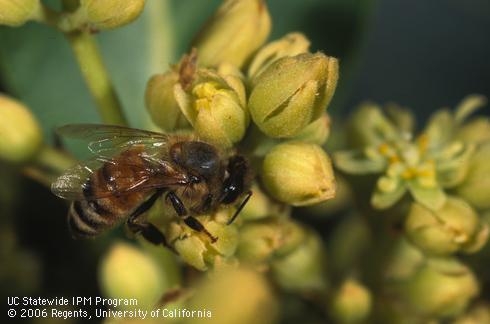
honey bee in avocado
Distorted Fruit and Mottled Leaves?
The word is getting out. If you have yellowish leaves, cupped/upright and the fruit is small, it may not be Huanglongbing (HLB), but it sure seems like all of my neighbors think so. It could be just lack of water, and in a drought, that could be the most likely cause. But there are other causes of symptoms that might be associated with HLB. Citrus Stubborn Disease causes these symptoms, but also distorted fruit and shriveled, discolored seeds, and bitter fruit like HLB. Under very hot conditions, leaves on some shoots may have misshaped, blunted yellow tips with mottling similar to the nutritional deficiencies seen in HLB. The leaves can have shortened internodes, so there's a bunchy growth habit like in zinc deficiency. Fruit are small, sparse and have early drop. Again, a lot like HLB. Even more so, though Stubborn can cause stunted, thin canopies. Misshapen fruit, though can be caused by bud mites in lemon, chimeras (spontaneous mutations) and Tristeza (a viral disease). Frost damage can add further to the confusion about symptoms that might be associated with HLB.
Citrus Stubborn Disease is a serious disease that leads to reduced fruit quality and yield. It occurs most commonly in oranges, but does show up in other citrus including lemon and mandarin. It's more commonly seen in older trees that were initially propagated with infected tissue, and growing in hot, dry environments. Unlike HLB, it doesn't lead to the death of the tree, just major loss of income. It's caused by a phytoplasma (a bacteria without a cell wall) and is spread by a leafhopper. There are other hosts like mustard and cabbage that can harbor the organism to be spread to new tissue and especially young trees. Warm winters favor the spread of the infected leafhopper, like we have had this winter.
So how do you distinguish between all the possible causes that look like HLB? HLB can be tested for as well as Tristeza. There are no commercial labs that check for Stubborn. It's basically a process of elimination then to decide to test for HLB or to think that the tree has the disease. So, know your trees and their history. Was there a freeze this winter? Know the effects and symptoms of drought and monitor soils and trees for water stress. Check for bud mite. It also takes time from the point of infected Asian Citrus Psyllid invasion to the time when symptoms of HLB start showing up in the tree. So keep your eyes open, but don't assume the worse at this point.
More on Tristeza:
http://www.ipm.ucdavis.edu/PMG/r107101311.html
Stubborn:
http://www.ipm.ucdavis.edu/PMG/r107101211.html
Images:
Misshaped fruit from Stubborn
Discolored seeds from Stubborn
Reduced canopy size from Stubborn
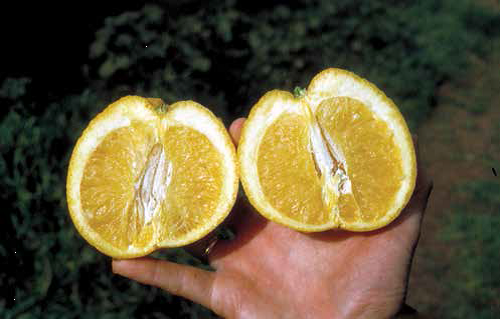
stubborn misshappened fruit
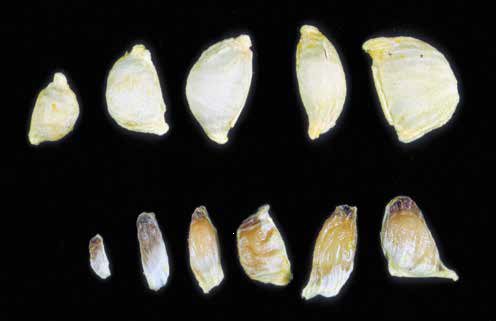
stubborn seeds
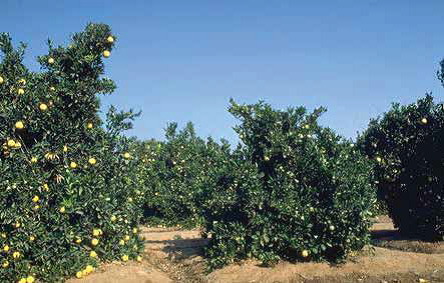
stubborn stunted growth

